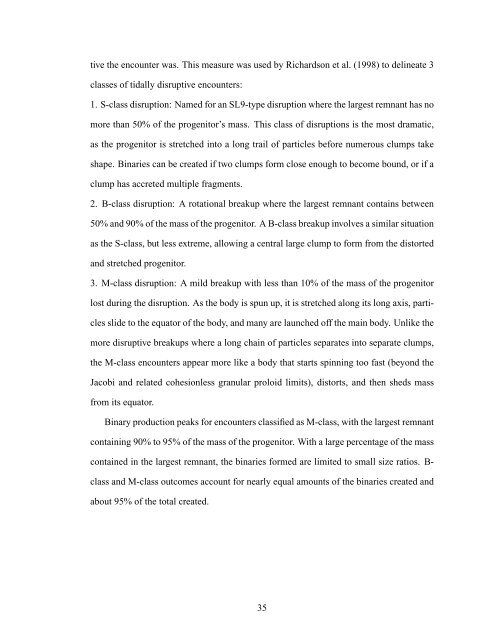Forming Binary Near-Earth Asteroids From Tidal Disruptions
Forming Binary Near-Earth Asteroids From Tidal Disruptions
Forming Binary Near-Earth Asteroids From Tidal Disruptions
Create successful ePaper yourself
Turn your PDF publications into a flip-book with our unique Google optimized e-Paper software.
tive the encounter was. This measure was used by Richardson et al. (1998) to delineate 3classes of tidally disruptive encounters:1. S-class disruption: Named for an SL9-type disruption where the largest remnant has nomore than 50% of the progenitor’s mass. This class of disruptions is the most dramatic,as the progenitor is stretched into a long trail of particles before numerous clumps takeshape. Binaries can be created if two clumps form close enough to become bound, or if aclump has accreted multiple fragments.2. B-class disruption: A rotational breakup where the largest remnant contains between50% and 90% of the mass of the progenitor. A B-class breakup involves a similar situationas the S-class, but less extreme, allowing a central large clump to form from the distortedand stretched progenitor.3. M-class disruption: A mild breakup with less than 10% of the mass of the progenitorlost during the disruption. As the body is spun up, it is stretched along its long axis, particlesslide to the equator of the body, and many are launched off the main body. Unlike themore disruptive breakups where a long chain of particles separates into separate clumps,the M-class encounters appear more like a body that starts spinning too fast (beyond theJacobi and related cohesionless granular proloid limits), distorts, and then sheds massfrom its equator.<strong>Binary</strong> production peaks for encounters classified as M-class, with the largest remnantcontaining 90% to 95% of the mass of the progenitor. With a large percentage of the masscontained in the largest remnant, the binaries formed are limited to small size ratios. B-class and M-class outcomes account for nearly equal amounts of the binaries created andabout 95% of the total created.35












